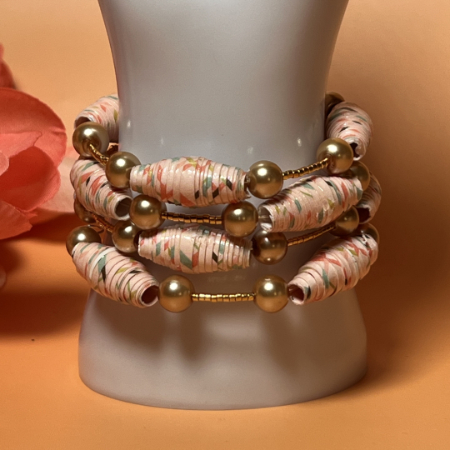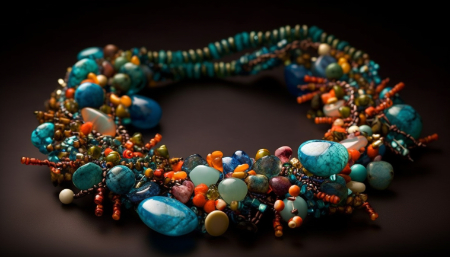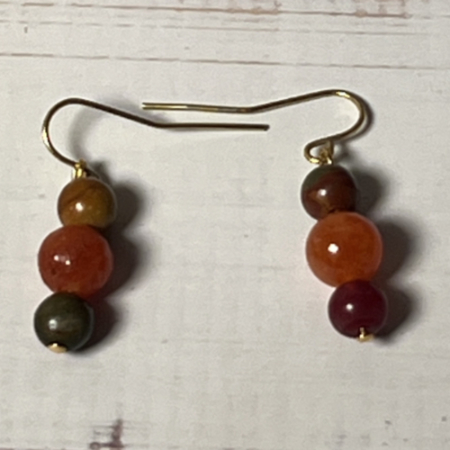
Have you ever looked at a junk mail pile and thought, “Well, this is just sad”? Let me introduce you to a new perspective. It’s the bold, brilliant world of unexpectedly fabulous rolled paper jewelry. In this world, yesterday’s catalog becomes today’s must-have accessory.
And leading the charge in this eco-chic revolution? The one, the only, the gloriously colorful Mixed Hues Necklace from Scott Jewelry Design. It’s like a confetti cannon and a sunset had a stylish baby. That baby grew up to make your outfits look phenomenal.
Wait… This is Made of Paper?
Yup. Paper. As in: the stuff you crumple into a grocery list. You panic over it during tax season. You absentmindedly doodle on it during Zoom calls. But don’t be fooled — this isn’t just any paper. This is paper with purpose. Paper that’s been transformed, sealed, and styled into one-of-a-kind jewelry that’s not only sustainable but drop-dead gorgeous.
It’s like Cinderella’s glass slipper story… but with a magazine and a glue gun.
The Mixed Hues Necklace is made entirely from hand-rolled beads crafted from richly colored, repurposed paper. Each bead is sealed for strength and shine. We’re talking water-resistant and ready for action. The beads are then arranged into a kaleidoscope of colors that play nice with literally everything in your closet. It’s bold. It’s unexpected. And it’s just begging to be complimented by strangers.
Jewelry with a Punchline (and a Purpose)
Let’s be honest — traditional jewelry can be kind of… snoozy. Gold? Nice. Silver? Classy. Diamonds? Sure, if you’re into being careful about everything all the time. But paper? Paper is where the fun starts. Paper jewelry is like wearing a wink. It’s unexpected. It doesn’t take itself too seriously. It still somehow manages to look like a million bucks. You won’t need to spend a million bucks.
The Mixed Hues Necklace doesn’t just sit there politely. It shows up. It adds personality. It says, “Yes, I recycle and I have great taste.” It goes with your little black dress and your favorite “I slept in this but still look cute” t-shirt. It’s that rare unicorn of an accessory: playful and practical.
Let’s Talk Versatility
One of the best things about the Mixed Hues Necklace? It goes with literally everything.
- All black outfit? Boom — instant pop of color.
- Bright floral dress? Yup — it’s already halfway to a friendship bracelet.
- Zoom meeting in pajamas from the waist down? Don’t worry, your neck is doing all the work.
- You woke up feeling like a quirky museum curator? This necklace gets you.
Each bead is slightly different in color, shape, and pattern. This means every necklace is as unique as your TikTok algorithm. It’s the kind of accessory that doesn’t just go with your outfit — it makes your outfit.
Is Rolled Paper Jewelry Lightweight? More Like Featherlight
You know that moment when you take off your jewelry at the end of the day? Your ears sigh with relief, and your neck feels like it’s finally free from a medieval torture collar. Yeah — the Mixed Hues Necklace doesn’t do that.
Rolled paper beads are ridiculously lightweight. You’ll forget you’re even wearing it. That is, until someone says, “Oh my gosh, I love your necklace — where’d you get it?” And then you get to say, “Oh, it’s made of rolled paper,” and watch their eyebrows launch into orbit.
It’s that kind of necklace. The kind that turns heads and starts conversations. You might get bonus points from strangers for being eco-conscious. Plus, being fashionable is a part of that package which, let’s be real, is the dream.
Why Rolled Paper Jewelry? Why Now?
Let’s review. The fashion world is waking up. More people want style that doesn’t contribute to waste, pollution, or low-quality fast fashion. Enter: rolled paper jewelry — handmade, eco-friendly, delightfully lightweight, and unapologetically fun.
And the Mixed Hues Necklace? It’s like the poster child for all of that — with just the right amount of sass. It proves that sustainable doesn’t have to mean beige. That eco-friendly doesn’t mean frumpy. And that paper doesn’t belong in the trash — it belongs on your neck.
Final Thought: Join the Paper Party
Do you feel like your wardrobe needs a little pep? Reach for the Mixed Hues Necklace from Scott Jewelry Design. If your look needs a conversation-starting twist, this necklace is a perfect choice.
Because you deserve accessories that are as bold, bright, and brilliantly unexpected as you are.
And seriously — when was the last time your necklace made people laugh? When did it make them stare or compliment you? Does it even respect your recycling habits?













